Spa & Health
THERMAL BATHS
Hungary > Central Hungary > Budapest
Thermal Baths:
What mostly attracts the tourists’ attention is the unique thermal and metical baths and spas with a natural supply of healing mineral waters. If you are looking for a rich cultural experience with medical or wellness treatments, then Hungary is the place that suits you best. The ancient Romans had a very developed bath culture in Hungary more than 2000 years ago. They highly valued the healing effects of Hungarian thermal waters. In the 16th century, the Turks built beautiful Turkish Baths, which are still in use today. The country sits on one of the richest geothermal and medicinal water resources in the world, thermal water can be found in 80% of the country. More than 1000 springs provide medicinal and thermal water to natural and medical spas. Budapest is probably the only major city in the world where so many thermal water can be found and have so much healing effects. You may experience a traditional bathing occasion how was the Turks' bathing culture and next to this enjoy the unparalleled healing effect.
The medical effects of Hungarian thermal waters are unique in the world. Relaxing in the hot water relieves stress and anxiety. Due to their chemical and biological components, medicinal waters are proven to remedy locomotor disorders, infertility, gynecological diseases and are beneficial in the rehabilitation process of sporting injuries. The water is also effective in treating chronic skin problems, such as eczema and psoriasis. Complex balneotherapeutical package is offered for patients suffering in the diseases mentioned above. Specialists such as rheumatologists, neurologists, dermatologists, cardiologists and rehabilitation therapists work together at spas and thermal baths. Mineral water is free from any chemical or microbiological contamination and additives. Moreover, as mineral waters are calorie-free, whether you bathe in medicinal water or drink it, you will feel better inside and out.
Széchenyi Thermal Bath:
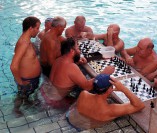 |
 |
 |
Széchenyi Thermal Bath is the largest bath in Europe having thermal water in it. It's water comes from two thermal springs and due to this fact the temperature is between 74 C and 77 C.
The water contains high level of sulphate, calcium, hydrogen carbonate and fluoride. Demonstrated by medical feedback, for patients with arthritis or having orthopaedical problems are highly recommended, and helps in the healing.
The bath is located in the City Park, and was built in 1913 in neo-baroque style, the designer was Győző Czigler. At that time women and men could not bathe together neither in steam rooms nor in the public bathing area. The complex was extended in 1927 and became to have 3 outdoor and 15 indoor pools. Due to the expansion, they had to drill a new source of mineral water because one source could not feed the entire bath. The second source was found in 1938 and since it feeds the pools.
Visitors may rent towels and bathing suits at site as well. The bath is easily accessible for all, since it is one of the stops of the yellow M1 line (Millennium Underground)
Services:
- ticket
- Aroma massage (It is a medical massage with aroma oils for your whole body. Time: 30 minutes)
- Refreshing massage (Full body massage with oil in swedish style. t is a medical massage with aroma oils for your whole body.)
- Luxury Manager massage (By stimulating various acupressure points on the neck, back and shoulder this massage helps relieve daily stress. Time: 60 minutes)
- Deluxe massage (wedish style Refressing and relaxing massage which helps to find the right posture to ease the pain. Time: 60 minutes)
- Harmony massage (Touch and sensing the fragrances together have a beneficial effect, directly through the skin. Time: 60 minutes)
- I love Spa Package (full day entry ticket including private cabin use , towel, flip-flops, swimming cap, 2 in 1 shampoo and shower gel, 0,5 l Ave still mineral water)
Gellért Thermal Bath:
 |
 |
 |
Gellért Thermal Bath is a thermal and swimming pool complex in Budapest, which was built between 1912 and 1918 during the Art Nuoveau. During the Second World War, some of its parts damaged but since it has been rebuilt and continued welcoming visitors. The healing water was already found in the 13th century in this area of Budapest, where before the bath was built a hospital was operating.
The thermal complex includes thermal baths, which offers many smaller pools for its visitors or healing patients. The water contains calcium, magnesium, hydrogen, bases, sulfate and fluoride, which ingredients are effective in curing patients with joint and spine problems, arthritis, circulatory disorders, vertebral disk disorders or many more. Two different kind of pools have healing effects, one of them is 36 C the other is 38 C and their walls are covered with beautiful tiles.
The current thermal complex and hotel opened in 1918, expanded in 1927, and then was further expanded with artificial wave pool and hot tub in 1934.
The complex also includes saunas and a plunge pool (which is separated by gender), the outdoor pool, where artificial waves sparkle the water in every 10 minutes. The Finnish sauna and the children’s pool is inside the complex, located indoor. In addition to these services, masseurs are available to help in the more effective recovery.
Services:
- ticket
- Magic of the Hot Stone massage (Lava stone massage improves blood and lymph circulation, loosens muscles, tension relieves muscle pains, warms the body, resolves muscle stiffness and energy blockages, which is responsible for disharmony in our body. Time: 60 minutes)
- Gellért Aroma massage (It is a medical massage with aroma oils for your whole body. Time: 30 minutes)
- Massage a' la Gellért (Powerful, energetic, and refreshing massage for the whole body. Time: 70 minutes)
- Danube dream (During the treatment wonderful oils, creams and relaxing music are offered for the full experience. It also includes a face and decolletage massage. Time: 60 minutes)
- Refreshing massage (Full body massage with oil. Swedish style refreshing and relaxing massage which helps to improve posture and to ease pain. Time: 60 minutes)
- Luxury Manager massage (By stimulating various acupressure points on the neck, back and shoulders this massage helps relieve daily stress. Time: 60 minutes)
- Harmony massage (Touch and fragrances together have a beneficial effect, directly through the skin. The oil massage stimulates circulation; the volatile oils embrace the body and take their effect through inhalation. Time: 60 minutes)
- Chocholate Dream massage (Skin scrubbing sugar peeling gel, Wrap, Chocolate massage. Time: 60 minutes)
- Traditional Thai Massage (The main effect of the massage is to balance the energy system. The massage tries to ensure a free energy flow by pressing and stretching the muscles. Time: 60-120 minutes)
- Thai Herbal Massage (This type of massage is a combination of medicinal herbs will be wrapped in the cotton cloth and heated over a steamer or hot pot before use to knead firmly on the aching and pain areas. Time: 60-120 minutes)
- Thai oil massage (Thai massage with oils is s special version of the traditional Thai massage. In this case the massage is not given in clothes. Touch and sensing the fragrances together have a beneficial effect, directly through the skin. Time: 60-120 minutes)
- Thai foot massage (the masseuse uses her fingers and special sticks for t he massage, together with special creams and oils. Time: 30-60 minutes)
- Thai Back-neck-shoulder traditional thai massage (This is a dry treatment, without oil. The massage eliminates the stress and refreshes the tired body. Time: 30 minutes)
- Face-head massage (This massage relaxes and tranquillizes. Time: 20-30 minutes)
Király Bath:
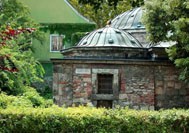 |
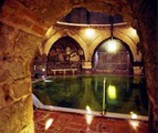 |
 |
The Bath was built in 1565. Unlike the other baths, it wasn't built into a natural water source, but the Lukács Bath's water feeds its thermal pools. With this, the Turks’ idea was to have a castle during a siege, otherwise to have a beautiful bath during peace time. The name comes from the King family, since they lived here until 1796.
The bath had to be rebuilt; however the today's form includes the old elements as well. The inside suffered from serious damage during the Second World War, but was rebuilt in 1950. Thus, in addition to Rudas Bath, Király Bath is the only thermal bath where the visitors can have a bathroom experience as it was in the authentic Turkish culture.
Today many type of diseases are treated here, for example musco-celetal diseases. The underwater jet massage and medical massage is also available for visitors.
Császár Bath:
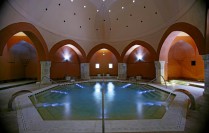 |
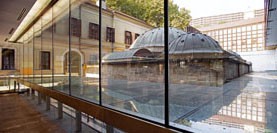 |
The most beautiful Turkish bath in Buda!
According to Csaba Virág's plans, the Bath was rebuilt in 1570. The central space is covered with a huge dome, which is surrounded by four smaller domes and arches, with these, the inside area of the building is divided into 9 parts. The walls and the floor are made of red limestone, which was rebuilt between 1841 and 1848 by József Hild, trying to preserve the original form.
Lukács Bath:
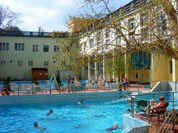 |
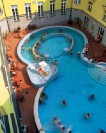 |
 |
Lukács Bath was built in the 12th century and was mainly used for curing sick and the knights. Later on, during the Turk invasion, the bath was not used for curing, but for guard gunpowder and wheat grinding. After the recaputre of Buda in 1844, Fülöp Palotay bought the bath and renovations started thanks to which the bath and the treasury is still alive today. Within the renovation, a new hypotherapic department was opened as well and became to have a great reputation worldwide. Many patients came here to heal, and in gratitude a marble plaque was placed into the courtyard.
In 1973, a drinking hall was built next to the bath, than a a thermal complex department followed this, which was operated as a day hospital as well. In 1797, the bath received its present name, Lukács Bath. In 1999 the outdoor pools were upgraded. The old mud pondwas replaced with a fun pool including a swirl corridor, underwater hot tub, neck massage, water beam back massage and a hot tub as well. Today the water filtration systems are upgraded for a more comfortable recovery.
Rudas Bath:
 |
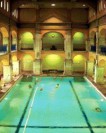 |
 |
The bath was built in 1550, and then reconstructed by Pasha Sokoli Mustafa in 1566. Some of the Turkish-period features are still used today: the octagonal pool, the four small corner pools, each with water of a different temperature, and the characteristic Turkish dome. In its drinking hall, the water of the springs Hungária, Attila and Juventus can be consumed for the purposes of a drinking cure. In the bath, there is a daytime outpatient hospital operating with a complex physiotherapy department.


